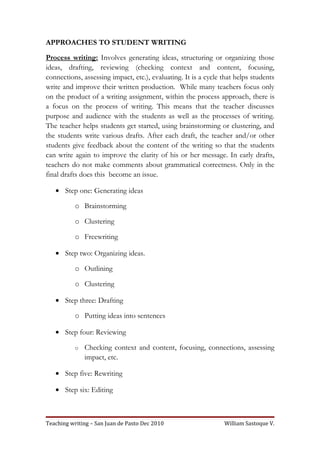
Approaches to student writing 2
- 1. APPROACHES TO STUDENT WRITING Process writing: Involves generating ideas, structuring or organizing those ideas, drafting, reviewing (checking context and content, focusing, connections, assessing impact, etc.), evaluating. It is a cycle that helps students write and improve their written production. While many teachers focus only on the product of a writing assignment, within the process approach, there is a focus on the process of writing. This means that the teacher discusses purpose and audience with the students as well as the processes of writing. The teacher helps students get started, using brainstorming or clustering, and the students write various drafts. After each draft, the teacher and/or other students give feedback about the content of the writing so that the students can write again to improve the clarity of his or her message. In early drafts, teachers do not make comments about grammatical correctness. Only in the final drafts does this become an issue. • Step one: Generating ideas o Brainstorming o Clustering o Freewriting • Step two: Organizing ideas. o Outlining o Clustering • Step three: Drafting o Putting ideas into sentences • Step four: Reviewing o Checking context and content, focusing, connections, assessing impact, etc. • Step five: Rewriting • Step six: Editing Teaching writing – San Juan de Pasto Dec 2010 William Sastoque V.
- 2. o Checking minor details like spelling, punctuation and grammatical correctness. The major disadvantage to process writing is the time needed. There are many benefits, such as integrating writing with other skills/activities, more writing practice, better final product, etc. Controlled-to-free approach: This is based on the audio-lingual approach, where writing was to speaking. Writing practice was used to perfect grammatical control. This approach is appropriate for high beginner to low intermediate students who need to develop confidence in their writing skills. In this approach, the teacher gives the students the parts of sentences and has them write complete sentences using the parts. They may also have students copy sentences or short paragraphs or even manipulate sentences grammatically. This controlled writing gives students writing practice without making errors, so they develop confidence in themselves. Later, the teacher has students write their own sentences based on the models already given in the controlled phase. The first phase of controlled writing should definitely not be used as the exclusive method for practicing writing and should be limited in its use. Students should be encouraged to move on to creative free writing in order to get more enjoyment out of their writing activities. Free writing approach: this approach focuses on quantity rather than quality. There are a lot of assignments (for example in a journal), and there is minimal correction. The teacher emphasizes content and fluency more than form and grammar. This approach is very affective for intermediate to advanced students to help them overcome fears of making mistakes. The emphasis on content and the freedom to make mistakes helps them learn to express themselves fluently. One additional benefit is that through the extensive practice, the students make a great deal of progress in their grammatical control, even without the teacher’s constant feedback. Paragraph pattern approach: in this approach, the teacher stresses organization of paragraphs and essays rather than grammar or fluency. Paragraphs are copied and analyzed and later imitated. For example, teacher Teaching writing – San Juan de Pasto Dec 2010 William Sastoque V.
- 3. give students the sentences of a paragraph in random order, and they have to organize them. There is work on topic sentences and the organization of the body of a paragraph. The study of essays works similarly: teachers give students essays to analyze and to imitate. The paragraphs of an essay are given randomly to students, and they have to reconstruct the original essay, analyzing and explaining the organization of the paragraphs. Communicative approach: This approach stresses the purpose of a piece of writing and its audience. Students think of why they are writing and who will read it. Writing is considered to be communication, so expanding the audience is an important factor (the audience should include more people than just the teacher). There is also a focus on responding to other people’s writing and making comments about content without focusing heavily on correcting errors. • Writing and genre. Study samples of different genres before producing them. Students need to have knowledge of the topic, conversations and styles of the genre, as well as the context in which it will be read and who the reader will be. This type of “imitation” is good to get to know how to manage a genre, and more creative writing can come later. Creative writing: This is usually imaginative, for example, poetry, stories, plays. Creative writing is more engaging for most students and they tent to work harder. It tends to be based on personal experiences. We can find ways to publish students’ creative writing, on bulletin boards, in a class newspaper, on the internet, etc. • Journal writing. • Writing as a cooperative activity. Group writing activities are good once in a while to stimulate creative and even research. Some can be games- like activities and others can be more serious, in-depth genre studies, for example. • Using the computer. There are many benefits of using a computer in writing class. Unfortunately, many teachers don’t know how to use this resource well. It is possible to have key pals, to have chat sessions, as well as other internet-based activities, but it is also good for doing Teaching writing – San Juan de Pasto Dec 2010 William Sastoque V.
- 4. communicative activities with the word processing program. Blogs play an important role here too. Teaching writing – San Juan de Pasto Dec 2010 William Sastoque V.
